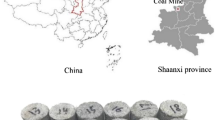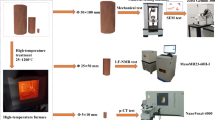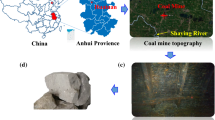Abstract
The coal-bearing strata in the Ordos Basin, China, formed in the Jurassic, and the associated sandstone aquifer is characterized by a short diagenesis time and weak cementation. Affected by seepage erosion, interstitial materials migrate inside the sandstone formation, resulting in changes in porosity and permeability over time and ultimately increasing the risk of mine water damage. Based on the combination of cast thin section (CTS) analysis, X-ray diffraction (XRD) testing, and nuclear magnetic resonance (NMR) testing, the changes in the porosity and pore structure parameters of medium-grained sandstone and coarse-grained sandstone under seepage were studied. On this basis, the relationship between porosity and seepage erosion time, porosity composition, and pore size was also established using the T2 spectrum distribution curve of weakly cemented sandstone samples obtained by NMR. The results show that the medium-grained and coarse-grained sandstone’s critical displacement pressures (DP) are approximately 0.5 MPa and 0.3 MPa, respectively. When the DP does not reach the critical value, the weak cementing material separates and moves inside the sample, leading to mutual conversion between pores of different sizes. Meanwhile, the total porosity changes only slightly. After DP exceeds the critical value, some weakly cemented substances can escape from the sample, significantly changing the microscopic pore structure inside the sample, increasing large-scale pores, enhancing water conductivity and increasing total porosity. These research results are of great theoretical significance for mine water disaster prevention and control in China’s western mining area.















Similar content being viewed by others
Data availability
The data that support the findings of this study are available from the corresponding author upon reasonable request.
References
Anovitz LM, Cole DR (2015) Characterization and analysis of porosity and pore structures. Rev Mineral Geochem 80(1):61–164
Chen Y, Liu DM, Cai YD, Gan Q (2018) Insights into fractal characteristics of pores in different rank coals by nuclear magnetic resonance. Arab J Geosci 11(19)
Darcy H (1856) Les Fontaines Publiques de la Ville de Dijon. Dalmont, Paris
Eshiet K, Sheng Y (2013) Influence of rock failure behaviour on predictions in sand production problems. Environ Earth Sci 70(3):1339–1365
Ji HG, Jiang H, Song ZY, Liu ZQ, Tan J, Liu YJ, Wu YF (2018) Analysis on the microstructure evolution and fracture morphology during the softening process of weakly cemented sandstone. J China Coal Soc 43(4):993–999 (In Chinese)
Jiang Y, Xu G, Bi H, Shi Y, Zeng X (2020) A new method to determine surface relaxivity of tight sandstone cores based on lf-nmr and high-speed centrifugation measurements. J Petrol Sci Eng 196:108096
Li Y, Yang J, Pan Z, Tong W (2020) Nanoscale pore structure and mechanical property analysis of coal: an insight combining AFM and SEM images. Fuel 260:116352
Liu, H. (2017). Principles and Applications of Well Logging.
Liu M, Xie RH, Guo JF, Jin GW (2018) Characterization of pore structures of tight sandstone reservoirs by multifractal analysis of the NMR T-2 distribution. Energy Fuel 32(12):12218–12230
Liu Q, Sun YJ, Li J (2020) Experimental study on seepage characteristics of jurassic weakly cemented sandstone under water-rock interaction. Geofluids 2020:8543687
Liu Q, Sun YJ, Xu ZM, Wang X, Zhang CX, Yao MH (2019) Pore media characteristics of Jurassic weak cemented sandstone and its significance for water-preserved coal mining. J China Coal Soc 44(3):858–865 (In Chinese)
Lowden BD, Porter MJ, Powrie LS (1998) society of petroleum engineers european petroleum conference - the hague, netherlands (1998) european petroleum conference. In: t2 relaxation time versus mercury injection capillary pressure: implications for nmr logging and reservoir characterisation
Ma D, Rezania M, Yu HS, Bai HB (2017) Variations of hydraulic properties of granular sandstones during water inrush: effect of small particle migration. Eng Geol 217:61–70
Mu Y, Hu ZM, Chang J, Duan XG, Li YL, Li YR, Niu WT (2021) Effect of water occurrence on shale seepage ability. J Petrol Sci Eng 204:108725
Papamichos E, Vardoulakis I (2005) Sand erosion with a porosity diffusion law. Comput Geotech 32(1):47–58
Papamichos E, Vardoulakis I, Tronvoll J, Skjærstein A (2010) Volumetric sand production model and experiment. Int J Numer Anal Met 25(8):789–808
Pettijohn FJ, Potter PE, Siever R (1972) Sand and sandstone. SpringerVerlag, Berrlin
Richards KS, Reddy KR (2007) Critical appraisal of piping phenomena in earth dams. Bull Eng Geol Environ 66(4):381–402
Shao XH, Pang XQ, Jiang FJ, Li LL, Huyan YY, Zhene DY (2017) Reservoir characterization of tight sandstones using nuclear magnetic resonance and incremental pressure mercury injection experiments: implication for tight sand gas reservoir quality. Energy Fuel 31(10):10420–10431
Song YJ, Zhang LT, Chen JX, Che YX, Yang HM, Bi R (2019) Study on damage characteristics of weak cementation sandstone under drying-wetting cycles based on nuclear magnetic resonance technique. Chin J Rock Mech Eng 38(4):825–831 (In Chinese)
Tian JL, Wang HM, Liu XX, Xiang L, Sheng JC, Luo YL, Zhan ML (2022) Study on permeability characteristics of sandstone considering pore compression sensitivity at different scales. Rock Soil Mech 43(2):405–415
Vardoulakis I, Papanastasiou P, Stavropoulou M (2001) Sand erosion in axial flow conditions. Transport Porous Med 45(2):267–280
Wang S (2020) The evolution of sandstone pore size under different pressures based on NMR (doctoral dissertation). China University of Mining and Technology
Wang G, Qin XJ, Shen JN, Zhang ZY, Han DY, Jiang CH (2019) Quantitative analysis of microscopic structure and gas seepage characteristics of low-rank coal based on ct three-dimensional reconstruction of CT images and fractal theory. Fuel 256:115900
Wu YQ, Tahmasebi P, Lin CY, Zahid MA, Dong CM, Golab AN, Ren LH (2019) A comprehensive study on geometric, topological and fractal characterizations of pore systems low-permeability reservoirs based on SEM, MICP, NMR, and X-ray CT experiments. Mar Petrol Geol 103:12–28
Xiao DS, Lu SF, Yang JX, Zhang LC, Li B (2017) Classifying multiscale pores and investigating their relationship with porosity and permeability in tight sandstone gas reservoirs. Energy Fuel 31(9):9188–9200
Yao BH, Chen ZQ, Cai W, Chen ZQ (2012) Stress distribution characteristics of paleokarst collapse breccia pipe and water inrush prediction study. Electron J Geotech Eng 17(6):769–784
Zhang Y, Niu S, Du Z (2020) Dynamic fracture evolution of tight sandstone under uniaxial compression in high resolution 3D X-ray microscopy. J Petrol Sci Eng 195:107585
Zheng Q, Xu Y, Hu H, Qian J, Gao X (2020) Quantitative damage, fracture mechanism and velocity structure tomography of sandstone under uniaxial load based on acoustic emission monitoring technology. Construct Build Mater 272(11)
Zhou XP, Li CQ, Zhou LS (2020) The effect of microstructural evolution on the permeability of sandstone under freeze-thaw cycles. Cold Reg Sci Technol 177:103119
Acknowledgements
The authors are extremely grateful for the financial support from these organizations.
Funding
Financial support for this work was provided by the Natural Science Foundation of Shandong Province (No. ZR2021MD016), the National Natural Science Youth Foundation of China (No. 52304239), and the National Natural Science Foundation of China (No. 51509148).
Author information
Authors and Affiliations
Corresponding author
Ethics declarations
Competing interests
The authors declare no competing interests.
Rights and permissions
Springer Nature or its licensor (e.g. a society or other partner) holds exclusive rights to this article under a publishing agreement with the author(s) or other rightsholder(s); author self-archiving of the accepted manuscript version of this article is solely governed by the terms of such publishing agreement and applicable law.
About this article
Cite this article
Zhang, W., Zhang, D., Han, C. et al. Experimental investigation of the microstructural evolution of weakly cemented sandstone under seepage erosion. Bull Eng Geol Environ 82, 440 (2023). https://doi.org/10.1007/s10064-023-03471-2
Received:
Accepted:
Published:
DOI: https://doi.org/10.1007/s10064-023-03471-2




